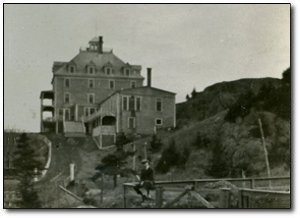|
Cape Forchu Community
Founding
Cape Forchu – Forked Cape, in English – was named by French explorer Samuel de Champlain in 1604.
Industry
Shipping, fishing, tourism (hotels/resorts)
|

|
|
Facts
- Cape Forchu was home to several popular summer resorts, including Bayview Lodge, Bayview Park and Hotel, and the Markland Hotel.
- The controversial “Runic Stone” was discovered by Dr. Richard Fletcher in 1812, on his property near the Salt Pond dyke. The origins of the stone, which now resides at the Yarmouth County Museum, remain a mystery.
- In 1764, John Sollows launched the first vessel to be built in the township at Fish Point.
- Cape Forchu Lighthouse was hit by lightning three times in the 1800s, each time with some damage.
- The greatest shipwreck ever to occur in the vicinity of the Cape took place in 1930, when the freighter Linton went ashore during a heavy snowstorm. The entire crew of eight was lost.
History
Cape Forchu is an island separated from the mainland by a narrow channel. It is surrounded by three bodies of water: Yarmouth Harbour, the Bay of Fundy, and the Atlantic Ocean. Small ships of the 1800s could pass to and from the bay through the channel.
The first road, Forchu Road, was constructed between Fish Point through Overton to Chegoggin Dyke and across to Pitch Hill, down Mill Hill to the main road. Later Lovitt’s Road (now Grove Road) was built along the harbour side, to Pitch Hill.
Although Cape Forchu’s waterfront location later made it a prime site for cottages, small homes, and several summer resorts, it is best known as the location of the Cape Forchu lighthouse. The lighthouse was established by the Nova Scotia Board of Works in 1839 and put in operation in January 1840, where it weathered many storms over the years. The structure was pulled down in 1961 and a larger structure was rebuilt in the same location. Today, the Cape Forchu lighthouse is a popular tourist attraction for visitors.
|
